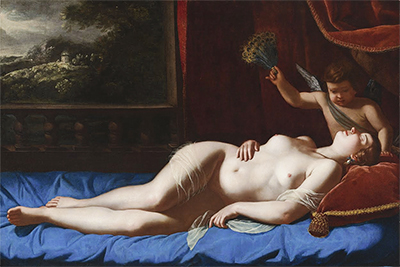Venus and Cupid (Sleeping Venus) is a 1626 artwork by the female Italian painter Artemisia Gentileschi. The painting shows Venus asleep, naked, lying on her blue bed. Cupid, who is her son, is fanning her with some peacock feathers to keep pests away, and watching over her adoringly.
A faraway temple can be seen through the window. The painting can now be viewed in the Virginia Museum of Fine Arts. The blue bed in the oil painting stands out so vividly, as it was painted with a double coat of lapis lazuli, which was a very expensive material, at the time, for artists. This lends to the thought that the painting could have been done as a commission for a rich client. It is also thought that the landscape scene through the window could have been completed by a second artist.
She was an admirer of Caravaggio, as was her father, and this can be seen in Venus and Cupid, in the form of the light around Venus's body, and the dark in the rest of the scene. Caravaggio often had dark and light contrasts in his artwork, and this technique was used by the artists he influenced. Artemisia Gentileschi was an extremely important figure in the world of art. She was the first female to be granted membership of the Accademia di Arte del Disegno, Florence. She specialised in painting women and was particularly talented when detailing their bodies.
She was initially taught by her father, Orazio Gentileschi, in his workshop. When he wanted her to progress further, he asked his friend Agostino Tassi to teach her, but Tassi sexually assaulted her, and this tainted her reputation. She channelled some of her anger towards Tassi into her artwork. Artemisia went on to marry the artist Pierantonio Stiattesi, and they had a daughter called Prudentia, named after Artemisia's late mother. Artemisia taught her daughter to paint, but any work she produced is unknown.
She was thought of very highly by Michelangelo Buonarroti the Younger, who was Michelangelo's nephew, and he asked her, along with other artists, to paint on the ceiling of the house he was building (Casa Buonarroti), in homage to his uncle and his work on the ceiling of the Sistine Chapel. She painted the Allegory of Inclination, which featured a naked woman with a compass, who slightly resembles Artemisia herself.




